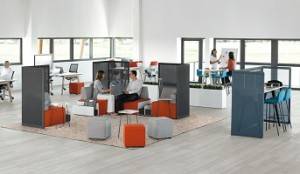April 15, 2014
The six most important dimensions of wellbeing in the workplace
 Designing an office environment using six key elements of wellbeing will benefit both employers and their staff, leading to a healthier, more productive workplace finds a new report. Steelcase’s WorkSpace Futures global research team, which included a psychologist, a designer and an ergonomist conducted an in depth study on existing wellbeing research, surveys, indicators and theories and found that the key to physical and mental wellbeing is the emotional experience, which can be influenced by a person’s surroundings, actions, and way of perceiving the world. The six dimensions of wellbeing that can be impacted by the design of the physical environment are; optimism, mindfulness, authenticity, belonging, meaning and vitality. Together these create what Steelcase refers to as an “interconnected workplace,” that offers employees choice and control over where and how they work.
Designing an office environment using six key elements of wellbeing will benefit both employers and their staff, leading to a healthier, more productive workplace finds a new report. Steelcase’s WorkSpace Futures global research team, which included a psychologist, a designer and an ergonomist conducted an in depth study on existing wellbeing research, surveys, indicators and theories and found that the key to physical and mental wellbeing is the emotional experience, which can be influenced by a person’s surroundings, actions, and way of perceiving the world. The six dimensions of wellbeing that can be impacted by the design of the physical environment are; optimism, mindfulness, authenticity, belonging, meaning and vitality. Together these create what Steelcase refers to as an “interconnected workplace,” that offers employees choice and control over where and how they work.
Psychologist Beatriz Arantes who led the research commented: “To foster wellbeing, employees need to have a variety of work settings that they can choose from.
“Traditionally workplaces have been designed for efficiency, and sometimes take a ‘one-size-fits-all’ approach. But that doesn’t offer employees the ability to choose the right kind of setting for the work they need to do. When they have choices, employees have a sense of control that helps them feel more empowered, engaged and less stressed.”
She explains the three key ways to offering this level of choice and control are:
Palette of Place: An ecosystem of interrelated zones and settings that provide users with a range of spaces that support their various modes of work.
Palette of Posture: A range of solutions that encourage people to sit, stand and move while supporting the multiple technologies they use.
Palette of Presence: A range of mixed-presence experiences (physical and virtual) in workplace destinations designed to augment human interaction.
Combined in workplace design, these principles lay the groundwork for addressing the six key dimensions of worker wellbeing, which are:
- Optimism: Fostering Creativity and Innovation
- Mindfulness: Fully Engaged
- Authenticity: Really Yourself
- Belonging: Connecting to Others
- Meaning: A Sense of Purpose
- Vitality: Get-up-and-go
As the researchers note, while many employers might think their findings ‘too soft’ an issue to tackle, especially as emotions have traditionally been excluded and divorced from the workplace; “we believe deeply in our insights, and this is why we want to share our message. It is within the best interest of organizations to support the wellbeing of workers, and the way to do so is to create positive emotional experiences at work.”
For more information on the research visit: https://360.steelcase.com/issues/wellbeing-a-bottom-line-issue/



















